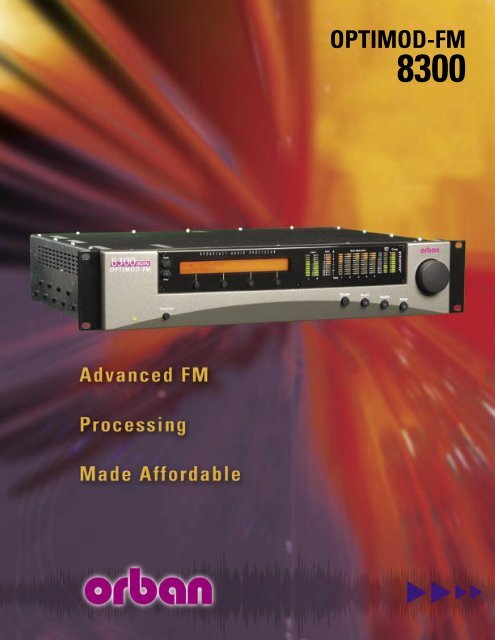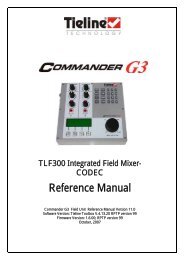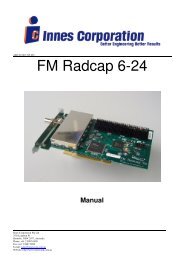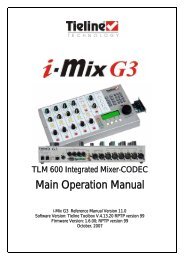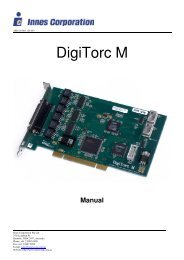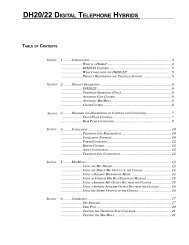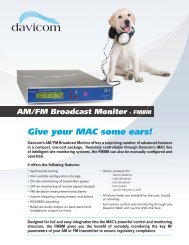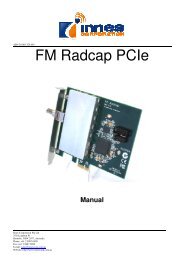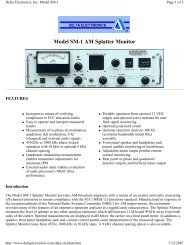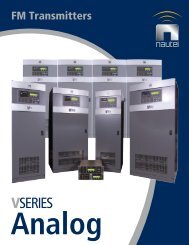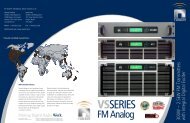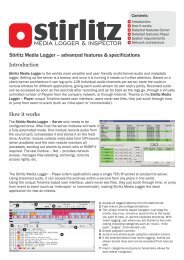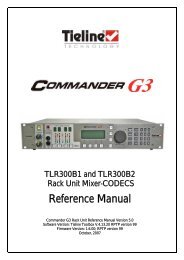Optimod-FM 8300
Optimod-FM 8300
Optimod-FM 8300
You also want an ePaper? Increase the reach of your titles
YUMPU automatically turns print PDFs into web optimized ePapers that Google loves.
OPTIMOD-<strong>FM</strong><br />
<strong>8300</strong>
Ever since Orban introduced OPTIMOD-<strong>FM</strong> 8400, stations that could not afford its admittedly premium price have coveted the loudness,<br />
cleanliness, competitiveness, and consistency that only an 8400 could provide. But good things come to those who wait. OPTIMOD-<strong>FM</strong> <strong>8300</strong> is a<br />
mid-priced processor with many of the sound processing features that were previously available only to 8400 owners.<br />
The 8400 has developed a reputation as the <strong>FM</strong> processor that provides the best consistency and cleanest speech, and the <strong>8300</strong> reflects this sonic<br />
legacy. Quality sound is what <strong>8300</strong> is all about—sound that attracts audiences by providing a polished, outstandingly professional presentation<br />
regardless of format and source material. Exceptional versatility allows you to adjust the processor’s audio texture to brand your sound, knowing<br />
that the resulting signature sound will remain consistent, cut to cut and source to source. Branding builds businesses, and no other processors<br />
have the consistency to brand your sound like OPTIMODs.<br />
With the <strong>8300</strong>, your signature sound is just a preset away. An easy, one-knob Less/More adjustment allows you to customize any factory preset,<br />
trading cleanliness against processing artifacts according to the requirements of your market and competitive environment. Full Control gives you<br />
the versatility to customize your audio further. And, if you are a hard-core processing expert, you can explore Advanced Control to tweak presets<br />
at the same level as Orban’s factory programmers.<br />
This versatility makes the <strong>8300</strong> a superb choice for any format. Its five-band processing is ideal for any pop music format (even the most competitive<br />
and aggressive CHR), while phase-linear two-band processing yields ultra-transparent sound for classical, classic jazz, and fine arts broadcasters.<br />
Regardless of your choice, <strong>8300</strong>’s optimized technology ensures unusually high average modulation and coverage for a given level of subjective quality.<br />
Versatility does not stop with sound. The <strong>8300</strong>’s built-in stereo encoder, AES/EBU digital inputs and outputs, and analog I/O permit hassle-free<br />
interfacing to any broadcast plant, whether the <strong>8300</strong> is located at the studio or the transmitter. Tight band limiting to 15 kHz means you can use<br />
any uncompressed digital STL to pass <strong>8300</strong>-processed audio from studio to transmitter without compromising on-air loudness—there is no need<br />
to use STLs having 44.1 or 48 kHz sample rates.<br />
If you want to locate the <strong>8300</strong> away from the studio, you will be pleased by its three separate remote control ports—GPI contact closures, RS232<br />
serial, and built-in Ethernet for TCP/IP networks. The serial and Ethernet ports are supported by the supplied <strong>8300</strong> PC Remote Control application.<br />
This highly graphic Windows ® application allows you to do even more with the <strong>8300</strong> than you can do through its front panel, making remote control<br />
a pleasure.<br />
Built-in clock-based automation lets you automatically daypart the processing. You can control many other <strong>8300</strong> operating parameters too; the<br />
<strong>8300</strong>’s feature set fully exploits the processor’s DSP and computer-based control architecture.<br />
If you are concerned about latency because you need to feed live talent headphones off air, be assured that the <strong>8300</strong>’s low-latency (5 ms delay)<br />
processing will keep the most finicky talent happy. Or use optimum latency (15 ms delay) processing for the most competitive sound with delay<br />
that is still low enough to satisfy most any talent.<br />
Features<br />
User-Friendly Interface<br />
• An LCD and full-time LED meters make setup, adjustment and<br />
programming of OPTIMOD-<strong>FM</strong> easy—you can always see the<br />
metering while you are adjusting the processor. Navigation is by<br />
dedicated buttons, soft buttons (whose function is context-sensitive),<br />
and a large rotary knob. The LEDs show all metering functions of the<br />
processing structure (Two-Band or Five-Band) in use.<br />
Absolute Control of Peak Modulation<br />
• The <strong>8300</strong> provides universal transmitter protection and audio processing for <strong>FM</strong><br />
broadcast. It can be configured to interface ideally with any commonly found<br />
transmission system in the world.<br />
• The <strong>8300</strong> provides pre-emphasis limiting for the two standard preemphasis<br />
curves of 50µs and 75µs. Its pre-emphasis control is seldom<br />
audibly apparent, producing a clean, open sound with subjective<br />
brightness matching the original program.<br />
• The <strong>8300</strong> achieves extremely tight peak control at all its outputs—<br />
analog left/right, AES/EBU left/right, and composite baseband.<br />
• By integrating the stereo encoder with the audio processing, the <strong>8300</strong><br />
eliminates the overshoot problems that waste valuable modulation in<br />
traditional external encoders. The stereo encoder has two outputs<br />
with independent level controls, each capable of driving 75Ω in<br />
parallel with 47,000pF, (100ft/30m of coaxial cable).<br />
• The <strong>8300</strong> prevents aliasing distortion in subsequent stereo encoders<br />
or transmission links by providing bandwidth-limiting and overshootcompensated<br />
15 kHz low-pass filters ahead of the <strong>8300</strong>’s audio<br />
outputs and stereo encoder.<br />
• Anti-aliased clippers running at 256 kHz sample rate prevent any<br />
trace of “digital clipper” sound.<br />
Flexible Configuration<br />
• The <strong>8300</strong> includes analog and AES/EBU digital inputs and outputs.<br />
Both digital input and digital output are equipped with sample-rate<br />
converters and can operate at 32, 44.1, 48, 88.2, and 96 kHz sample<br />
rates. The pre-emphasis status and output levels are separately<br />
adjustable for the analog and digital outputs.<br />
• The <strong>8300</strong> has an internal, DSP-based stereo encoder (with a patented<br />
“half-cosine interpolation” composite limiter operating at 512 kHz<br />
sample rate) to generate the pilot tone stereo baseband signal<br />
and control its peak level. The composite limiter is a unique, “you<br />
can only do this in DSP” process that beats composite clippers by<br />
preserving stereo imaging while fully protecting the stereo pilot tone,<br />
RDS/RBDS, and subcarriers.<br />
• The analog inputs are transformerless, balanced 10kΩ<br />
instrumentation-amplifier circuits, and the analog outputs<br />
are transformerless balanced, and floating to ensure highest<br />
transparency and accurate pulse response.
• The <strong>8300</strong> has two independent composite baseband outputs with<br />
digitally programmable output levels. Robust line drivers enable<br />
them to drive 100 feet of RG-59 coaxial cable without audible<br />
performance degradation.<br />
• The <strong>8300</strong> has two subcarrier inputs that are mixed with the output of<br />
OPTIMOD-<strong>FM</strong>’s stereo encoder before application to the composite<br />
output connectors. One input can be re-jumpered to provide a 19 kHz<br />
pilot reference output. The other input has an internal level trim to<br />
accommodate subcarrier generators with output levels as low as 220 mV.<br />
• The <strong>8300</strong> precisely controls the audio bandwidth to 15 kHz. This<br />
prevents overshoots in uncompressed digital links operating at a 32<br />
kHz sample rate and prevents interference to the pilot tone and RDS<br />
(or RBDS) subcarrier.<br />
• The <strong>8300</strong> has a defeatable multiplex power limiter that controls the<br />
multiplex power to ITU-R BS412 standards. An adjustable threshold<br />
allows a station to achieve maximum legal multiplex power even if the<br />
downstream transmission system introduces peak overshoots into<br />
the <strong>8300</strong>-processed signal. Because this limiter closes a feedback<br />
loop around the audio processing, it allows the user to adjust the<br />
processor’s subjective setup controls freely without violating BS412<br />
limits, regardless of program material. The multiplex power limiter<br />
acts on all outputs (not just the composite output) and works by<br />
adjusting the thresholds in the multiband compressor instead of<br />
adding another wideband gain control stage. The limiter is thus<br />
entirely multiband, which minimizes spectral gain intermodulation.<br />
It reduces clipper drive when it reduces power, simultaneously<br />
reducing clipping distortion.<br />
• All input, output, and power connections are rigorously RFI-suppressed<br />
to Orban’s traditional exacting standards, ensuring trouble-free installation.<br />
• The <strong>8300</strong> is designed and certified to meet all applicable international<br />
safety and emissions standards.<br />
• The <strong>8300</strong> is HD-ready. A future software upgrade will allow you to<br />
route HD-specific processing to the AES/EBU output, while the analog<br />
and composite outputs continue to supply processing optimized for<br />
the <strong>FM</strong> analog channel [HD<strong>FM</strong> is a trademark of iBiquity Corp.]<br />
Adaptability through Multiple Audio Processing Structures<br />
• A processing structure is a program that operates as a complete<br />
audio processing system. Only one processing structure can be onair<br />
at a time. OPTIMOD-<strong>FM</strong> realizes its processing structures as a<br />
series of high-speed mathematical computations made by Digital<br />
Signal Processing (DSP) chips.<br />
• The <strong>8300</strong> features three processing structures: Optimum Five-<br />
Band (or “Multiband”; 15 ms delay) for a consistent, “processed”<br />
sound, free from undesirable side effects, Low-Latency Five-Band<br />
(5 ms delay) for environments where talent monitors live off-air and<br />
they object to the delay of Optimum Five-Band, and Two-Band for<br />
a transparent sound that preserves the frequency balance of the<br />
OPTIMOD-<strong>FM</strong><br />
original program material. A special Two-Band preset creates a<br />
no-compromise “Protect” function that is functionally similar to the<br />
“Protect” structures in earlier Orban digital processors. The Optimum<br />
Five-Band and the Two-Band structures can be switched via a mutefree<br />
crossfade; the Low Latency Five-Band structure causes a very<br />
brief audio mute when activated.<br />
• The <strong>8300</strong> can increase the density and loudness of the program<br />
material by multiband compression, limiting, and clipping. This<br />
improves the consistency of the station’s sound and increases<br />
loudness and definition remarkably, without producing unpleasant<br />
side effects.<br />
• The <strong>8300</strong> rides gain over an adjustable range of up to 25dB,<br />
compressing dynamic range and compensating for both operator<br />
gain-riding errors and gain inconsistencies in automated systems.<br />
• The <strong>8300</strong>’s Two-Band processing structure is phase-linear to<br />
maximize audible transparency.<br />
• The <strong>8300</strong> can import and run any 8400 “LL” (Low-Latency) preset via<br />
the <strong>8300</strong> PC remote application. This means that you can use an 8400<br />
to develop presets for <strong>8300</strong>, provided you do not use 8400 features<br />
not supported by the <strong>8300</strong>. (If you try to import an 8400 preset that<br />
uses features unsupported by <strong>8300</strong>, the <strong>8300</strong> will interpret that preset<br />
as best it can by using the available <strong>8300</strong> features—see the <strong>8300</strong><br />
Operating Manual for details.)<br />
Controllable<br />
• The <strong>8300</strong> can be remote-controlled by 5–12V pulses applied to eight<br />
programmable, optically isolated “general-purpose interface” (GPI) ports.<br />
• <strong>8300</strong> PC Remote software is a highly graphical application that runs<br />
under Windows 2000 and XP. It communicates with a given <strong>8300</strong><br />
via TCP/IP over modem, direct serial, and Ethernet connections.<br />
You can configure PC Remote to switch between many <strong>8300</strong>s via<br />
a convenient organizer that supports giving any <strong>8300</strong> an alias and<br />
grouping multiple <strong>8300</strong>s into folders. Clicking an <strong>8300</strong>’s icon causes<br />
PC Remote to connect to that <strong>8300</strong> through an Ethernet network, or<br />
initiates a Windows Dial-Up or Direct Cable Connection if appropriate.<br />
The PC Remote software allows the user to access all <strong>8300</strong> features<br />
and allows the user to archive and restore presets, automation lists,<br />
and system setups (containing I/O levels, digital word lengths, GPI<br />
functional assignments, etc.).<br />
• A Bypass Test Mode can be invoked locally or by remote control to<br />
permit broadcast system test and alignment or “proof of performance” tests.<br />
• OPTIMOD-<strong>FM</strong> contains a versatile real-time clock, which allows<br />
automation of various events (including recalling presets) at preprogrammed<br />
times.<br />
• OPTIMOD-<strong>FM</strong> contains a built-in line-up tone generator, facilitating<br />
quick and accurate level setting in any system.<br />
• OPTIMOD-<strong>FM</strong>’s software can be upgraded remotely through its<br />
serial port (connected to an external modem), or Ethernet port,<br />
or locally (by connecting a Windows ® computer to its serial port<br />
through the supplied null modem cable) and running Orban-supplied<br />
downloadable upgrade software.<br />
<strong>8300</strong>
Specifications<br />
It is impossible to characterize the listening quality of even the simplest limiter or<br />
compressor based on specifications, because such specifications cannot adequately<br />
describe the crucial dynamic processes that occur under program conditions. Therefore,<br />
the only way to evaluate the sound of an audio processor meaningfully is by subjective<br />
listening tests. Certain specifications are presented here to assure the engineer that they<br />
are reasonable, to help plan the installation, and make certain comparisons with other<br />
processing equipment.<br />
PERFORMANCE<br />
Specifications apply for measurements from analog left/right input to stereo composite<br />
output and to <strong>FM</strong> analog left/right output.<br />
Frequency Response (Bypass Mode): Follows standard 50µs or 75µs pre-emphasis curve<br />
±0.10 dB, 2.0 Hz–15 kHz. Analog left/right output and digital output can be user-configured<br />
for flat or pre-emphasized output.<br />
Noise: Output noise floor will depend upon how much gain the processor is set for (Limit<br />
Drive, AGC Drive, Two-Band Drive, and/or Multi-Band Drive), gating level, equalization,<br />
noise reduction, etc. The dynamic range of the A/D Converter, which has a specified<br />
overload-to-noise ratio of 110 dB, primarily governs it. The dynamic range of the digital<br />
signal processing is 144 dB.<br />
Total System Distortion (de-emphasized, 100% modulation): = 90 dB unweighted (Bypass mode, de-emphasized, 20 Hz–15 kHz<br />
bandwidth, referenced to 100% modulation).<br />
L/R Crosstalk: 600Ω<br />
SCA1 Sensitivity: Variable from 220 mV p-p to >10 V p-p to produce 10% injection.<br />
Sensitivity is adjustable by an internal PC-board-mounted trim control.<br />
SCA2 Sensitivity: Fixed at 772 mV p-p to produce 10% injection.<br />
Connectors: Two BNC, unbalanced and floating over chassis ground, EMI suppressed.<br />
19 kHz Pilot Reference: SCA2 input can be rejumpered to provide a 19 kHz pilot reference output.<br />
REMOTE COMPUTER INTERFACE<br />
Configuration: TCP/IP protocol via direct cable connect, modem, or Ethernet interface.<br />
Suitable null modem cable for direct connect is supplied. Modem is not supplied.<br />
Serial Port: 115 kbps RS-232 port DB9 male, EMI-suppressed.<br />
Ethernet Port: 10 Mbit/sec on RJ45 female connector.<br />
REMOTE CONTROL (GPI) INTERFACE<br />
Configuration: Eight (8) inputs, opto-isolated and floating.<br />
Voltage: 6–15V AC or DC, momentary or continuous. 9VDC provided to facilitate use with<br />
contact closure.<br />
Connector: DB25 male, EMI-suppressed.<br />
Control: User-programmable for any eight of user presets, factory presets, bypass, test<br />
tone, stereo or mono modes, analog input, digital input.<br />
Filtering: RFI filtered.<br />
POWER<br />
Voltage: 100–132 VAC or 200–264 VAC, switch-selected on the rear panel, 50–60 Hz, 40 VA.<br />
Connector: IEC, EMI-suppressed. Detachable 3-wire power cord supplied.<br />
Grounding: Circuit ground is independent of chassis ground, and can be isolated or<br />
connected with a rear panel switch.<br />
Safety Standards: ETL listed to UL standards, CE marked.<br />
Because engineering improvements are ongoing, specifications are subject to change without notice.<br />
Orban<br />
1525 Alvarado St. | San Leandro CA 94577<br />
+1 510.351.3500 | +1 510.351.0500 fax | www.orban.com<br />
CRL Systems, Inc.<br />
1302 W. Drivers Way | Tempe AZ 85284<br />
+1 480.403.<strong>8300</strong> | +1 480.403.8301 fax | www. crlsystems.com


